The pioneering lifestyle didn’t really lend itself to long leisurely lengths over the stove. If you weren’t married and, on the prairie, running cattle, trapping or logging, well, you would still need to eat but no one would be at home cooking for you. The perpetual soup (or stew) was used by pioneers to tackle this exact problem.
The idea behind the perpetual soup was that, with a well-managed fire, you could simmer broth and other ingredients in your kettle all day, maybe even for days.
The soup would be ready whenever you got time to swing by camp and you could add to it as you were paid or when you happened across some new ingredients.
Sometimes called Skilligalee, the perpetual soup was the answer they needed to help fuel their busy lives as homesteaders, ranchers, and cowboys. The pioneering lifestyle was brutal by today’s standards.
This is but one of the many ingenious ideas the pioneers developed in order to forge west and discover the unbelievable treasures of this great land.
Understanding Perpetual Soup
At its very base, perpetual soup is, well, soup. Soup is an ancient food item. In fact, Monsieur Boulanger, France’s first restauranteur served what he called “Restoratives” that were basically broths. Broths are not stocks.
Stocks are soup and sauce bases that are made from bones and vegetables and herbs. These are simmered for hours and strained.
Broth demands the inclusion of meat in a slow simmer. It’s usually the product of slow simmer bones and meat together. The perpetual soup or Skilligalee would include both meat and bones so its base would certainly be that of a broth.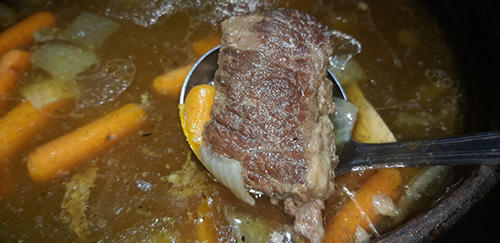 The soup would also require that you use hardy vegetables. This mixture would simmer for days at a time and would be added to along the way. Something like the stone story you read as a child. You can so easily keep the perpetual soup running for 60 days or longer if properly maintained.
The soup would also require that you use hardy vegetables. This mixture would simmer for days at a time and would be added to along the way. Something like the stone story you read as a child. You can so easily keep the perpetual soup running for 60 days or longer if properly maintained.
The Skills to Make Perpetual Soup
One skill would be of the utmost importance when it came to making perpetual soup. That would be managing your fire or controlling heat. This stew is rarely emptied due to the manner in which it cooks. Liquids are replenished and the ingredients blend keeps changing. But all this is impossible if you do not properly control heat.
Controlling Heat
The most important part of making perpetual soup is consistent, low heat. This means you must understand your fire. Alternatively, you can use a Dutch oven at home for cooking your skilligalee.
We started our perpetual soup on the stovetop to get it simmering and we cut heat even further overnight.
Controlling the heat round the clock would be very tough. Therefore, we chose to use cast iron. It holds heat longer. Alternatively, you can use a high quality hunter pot. We also kept the soup covered. This was very important once the soup moved outside.
Using the Right Ingredients
There are many more “right” ingredients for perpetual soup than there are wrong ones. You are cooking this soup for days and that means that you need ingredients that are going to hold up to the heat for days on end.
Hearty root vegetables are going to do the best. These are things like onions, potatoes, turnips, rutabagas, garlic, carrots, and parsnips.
Some ingredients that would be very bad choices would be things like rice and pasta. These two ingredients constantly absorb water and they will become mush after a few hours of cooking. So, stay away from these.
Related: Bean and Rice Survival Soup – Easy and Adaptable Recipe
Make Your Own
If we are going to make perpetual soup than we need to do it properly. That is over an open fire. We need this soup to cook over coals for a couple of days. We can add to the fire and add to the pot and the soup will get better and better as time goes on.
Tools
- Cast Iron Dutch Oven
- Ladle
Ingredients
- Cheap Cut of Beef
- Beef Soup Bones
- Onions
- Carrots
- Garlic
How to Make Perpetual Soup
#1. I used about 2lbs of boneless beef ribs mostly because they were on sale and cheap. No matter what cut of beef you put into the pot it’s going to be tender after 2 days of cooking.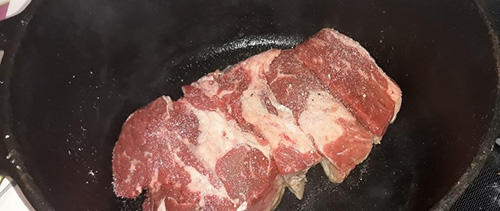 Sear your meat in the Dutch oven until you get some good brown color on the sides. Then add your soup bones to the pot before covering it all with cold water.
Sear your meat in the Dutch oven until you get some good brown color on the sides. Then add your soup bones to the pot before covering it all with cold water.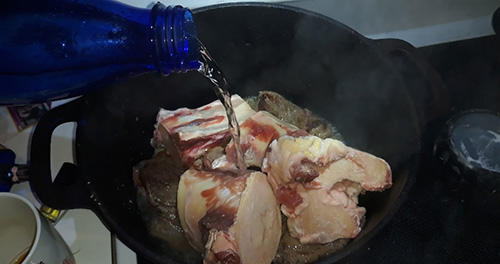 Cold water is key to drawing the flavor from bones. When making traditional stock you want to start with cold water and bring it up to a simmer very slowly.
Cold water is key to drawing the flavor from bones. When making traditional stock you want to start with cold water and bring it up to a simmer very slowly.
#2. We let the soup cook for 24 hours at a low simmer. I used my metal ladle to remove the foam and excess oil from collecting on the top of the soup. Dip the ladle just below the surface of the water and allow the fat and scum that is floating on the top to fall into the ladle. This is going to make a much better soup.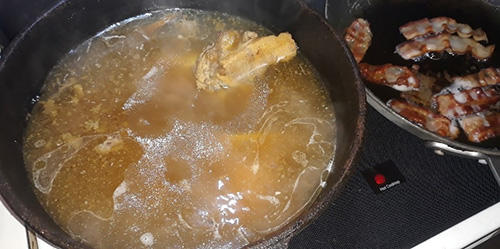 Then we added a dried cayenne chili and a couple dried shitakes from our logs.
Then we added a dried cayenne chili and a couple dried shitakes from our logs.
#3. We added our vegetables to the mix the next day and allowed that to simmer for another 12 hours. This was one of the most hands-off parts of making the soup. I did not ladle the scum or anything to see how it would look after 12 hours of cooking.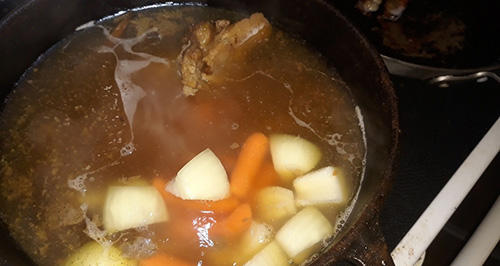 It was our way of simulating how the soup would cook while people might be away from camp.
It was our way of simulating how the soup would cook while people might be away from camp.
#4. Then we finished the soup outside over the fire to keep it a bit authentic. The beef was incredibly tender, and the vegetables were a little overcooked, as you can imagine. Some of the vegetables began to breakdown into the broth and the soup got murky from this.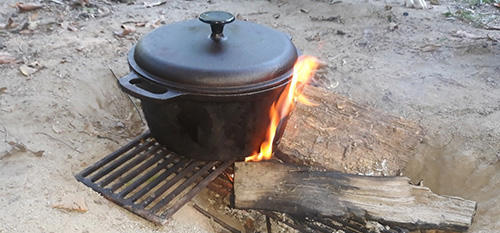 #5. The soup was ladled into bowls and served with some hard crusty bread.
#5. The soup was ladled into bowls and served with some hard crusty bread.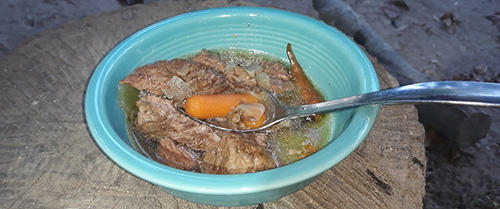 In our modern age, we have men who are very insecure. They think that by forgoing skills like cooking they are somehow becoming more of a MAN.
In our modern age, we have men who are very insecure. They think that by forgoing skills like cooking they are somehow becoming more of a MAN.
This shortsighted view of what a man is leaves out the fact that cowboys and pioneers who were not yet married or on the range did all their own cooking.
They couldn’t swing by Hooters for dinner. These men, who were savage forces of nature, cooked, cleaned and did their own laundry. Can you imagine trying to check one of these 19th-century frontiersmen on their “manhood” for cooking or enjoying their stew nights?
This perpetual stew is an example of how ingenuity was used to feed those who were hungry but too busy to sit around the fire and stir or flip a meal.
You may also like:
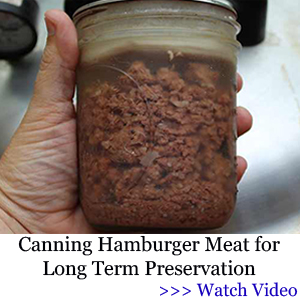 What Foods Can You Bury Underground For Winter?
What Foods Can You Bury Underground For Winter?
Cheap and Easy to Build Root Cellar in Your Own Back Yard (Video)
5 Survival Foods Made By Soldiers During WW2 On The Normandy Front

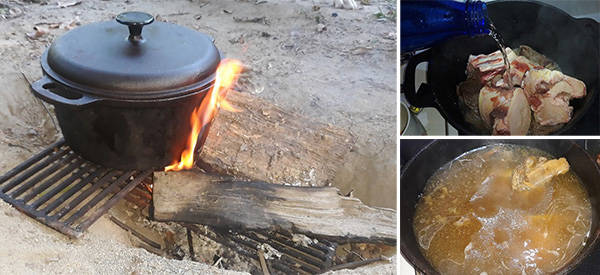













In our modern age, we have men who are very insecure. They think that by forgoing skills like cooking they are somehow becoming more of a MAN. Yeah and patching clothes are beneath them like a Singer does not even have the name machine in it. That is the biggest load of malarkey that I have ever heard. Sometimes people are proud of what they cannot do.
There is no mention of seasoning but I wonder if salt was used to add flavor?
Seasonings I consider condiments. I buy them at the dollar store and keep a few bottle of all of them . They’re cheap and make Dull boring food better.
Birdy, I would think so. Salt also works as a preservative.
I am writing this not as a caution. This is a report about an article I read many years ago. It may be cautionary. Then I will broach my methods along these lines.
A man had a pot of perpetual soup, or stew, whatever. His kids didn’t eat it, just him. I don’t recall how they got around testing it. They may have tested the man first. Man and stew had a dangerous pathogen that should have made him very sick, possibly unto death. It was said that it was good the kids didn’t eat it. It could have killed a child. They hypothesized that he cultivated a pathogen that could survive the reheating, and subsequent re-cooking of new ingredients. Further, he built up a resistance to the pathogen. There is an interesting discussion in, “Gut and Psychology Syndrome,” a book by Natasha Campbell-McBride, which discusses how a pathogen, (take tetanus for example), which would kill you if it got in your blood stream, may live in your digestive tract without killing you for decades, living off the food in your gut, releasing neuro-toxins into your system, affecting your health.
My method, I do something similar, especially in colder weather. I barbecue, (or bake), a large portion of meat, chicken, chicken parts, a roast, ribs, lamb. I make enough to have a lot of leftovers. The next day, I make a big stew. Usually, just some of the meat. I may use stock & wine, or I may use a tomato base with stock and wine. I use miripoix, parsley, other vegetables, garlic, ginger. I spritz the finished product in my bowl with lemon or lime. I may make a batch of turmeric, peel & chop/dice like ginger, saute in butter to release the healthful oil solvent components you don’t get if you cook with water. Once dissolved in oil, it can mix with water, or be small globules of fat in the stew. It may last a day or 3, I reheat, even for breakfast, Eggs broken into pockets formed in the stew, coming out like poached eggs, spooned on a wide bowl of the leftovers. I then make a second stew, change it up, go from with tomato to without, vice versa. I eat it Keto, or cook carbs separate, pasta, rice, barley, wheat. I make an evenings beef stew, adding barley, to a small individual pot, so it can be barley tonight, pasta tomorrow, Keto—no carbs—another night. Raw meat has a shorter fridge life than cooked. (Icebox-ed has a shorter life than refrigerated).
I take the ingredients in mind. I usually try to eat all the vegetables. They will be pretty tasteless after multiple reheats. I will strain all but the liquid, and cook fresh vegetables, adding the leftover meat and few vegetables from before just to reheat. Parsley, and spinach I add 2 minutes before it is ready, Broccoli 3 minutes before.
I sometimes make a dish I’m not wild about. I inevitably dump something into it to improve it, often going farther and farther from what I think of as edible. Those dishes usually wind up being dumped at some point.
Sometimes, Meat beginning to smell, but not full on spoiled, I’ll marinade it in a vinegar marinade, that kills the pathogen, and will smell fine if it wasn’t full on spoiled. Some might be put off by that practice, that’s fine.
My sensitivities would change in a Venezuela-style crisis.
In a Venezuela-style crisis even my dog would be looked at with an eye for considering his fat content.
Yep, in a time where life expectancy was from 30 to 40, I’m sure this soup did not help matters. Reheat food one time and it is called left overs. Reheat food several times and it is called food poisoning.
My reading of the article DOES NOT indicate any REHEATING. Instead, it repeatedly points to fire/temperature control, maintaining a CONSTANT SIMMER, thus not allowing temperatures conducive to spoilage of the soup to occur. If one MAINTAINS a CONTINUOUS SIMMER there will be no spoilage, and no food poisoning!!! For decades, the ‘Operator’ groups in our many refinery/petrochemical plants here [Port Arthur, TX] have maintained perpetual soups and/or stews for months by ‘feeding’ the continuously simmering pot with fresh meats and veggies every shift.
Go for it Johnny3. I for one will not. Need to keep someone keeping fire going 24/7. Fires go out and temps go down. No thanks
A responsible person, out of concern for their family, will always keep the home fires burning. Fires do not go out if attended to. We use a free-standing wood fired heater to keep our home warm from November til late March and even later. I tend the fire, stoking it in the evening before bed, and once again during the night , they remain lit 24/7. The same is done with a wood cook stove if in use. Soup or any other food with a liquid base will not, can not ,spoil when kept simmering. Microbial spoilage from pathogenic bacteria, molds, and yeast, along with the waste products they produce, cannot survive or even form in boiling or simmering water. So the potential problem of food poisoning lies with the cook not the process.
They didn’t reheat perpetual soup. It was always on simmer what we call the “safe zone.” It was a staple in every pioneer diet. Keep it hot and keep adding ingredients.
I’m curious, are the writers of this article still eating from their perpetual soup? I’m sorry but this is a horrible idea.
It makes me think of a scene in the excellent (TV?) movie about Lizzie Borden starring Elizabeth Montgomery. In the scene, her cheap father demanded that a pot of leftover mutton soup be served at dinner. During a heat wave. Lizzie goes to the stove and lifts the lid on a congealed mess while a fly is heard buzzing in the background. Yecchhh!
Personally, I can’t do leftovers more than a couple of days in a row. I’d rather cook smaller portions of something and switch it up while I still can.
If it freezes well, we make a double portion. When we get busy, it can be thawed out and heated. I boned 10 lbs of chicken legs and made Gen. Tso’s. Most of the chicken, after being cooked, can be frozen, then heated with a fresh batch of sauce. Leftover chili is mixed with a little cornmeal and used to stuff peppers, then baked with tomato juice and spices. niio
My understanding from reading contemporary accounts was that household skills were something that cowboys et al took enormous pride in. Good camp “Cookies” were prized, and were often wooed away from a job with an offer of better pay, perks, etc.
Likewise, a man with superior sewing skills could earn extra money by mending or altering clothing for his co-workers who lacked talent, or skills were traded. “I’ll write a letter to your gal if you fix the tear in my shirt.”
I agree, Miss Kitty. Cook, or Cookie was the most important member of the drive and the ranch. On farms, of course, the wife, if there was one was the cook along with the myriad of other chores she performed. It’s no wonder many women didn’t survive and those that did were tougher than rawhide.
The drudgery that women faced is mind numbing. It’s a wonder more of them didn’t commit suicide.
But, I’m willing to bet they were happier than many today.
Away much better pay than a cowhand. Most cowhands were in their teens, and tend to be practical jokers. If they messed with the coosie (cosinero) they got their coffee salted (horse pee). But men I worked with who did the job had all kinds of recipes, like buzzard lime pie, elk berry pie, cow flop cookies and much, much more. The cook gets respect or forces it on the boys. The cooise is often more powerful than the jefe. A man can always find a new job, but good cooks aren’t easy to come by. niio
I think some readers missed the point. I believe what the author is talking about is keeping the pot on the fire continually with the contents continually above 165°F so that pathogens cannot start. If one takes it from the fire, it is necessary to eat the whole thing and start over. You keep it on the fire until it is gone. You can add new ingredients to the pot the next morning or in the evening, but the pot stays on the fire. There is no danger of pathogens forming and food poisoning starting. Obviously if one is going to be forever reheating left over soup, eventually bugs are going to develop as the temperature falls below the death level for bacteria.
If the fire goes out so does the soup.
Quite often “cookie” kept that pot hot over hot coals while traveling in the wagon. Chow was ready to go when the day was done.
In Asia this was Mongolian Firepot, in Spain it was called Olla Podrida, and must have existed in lots of other cultures. The dish is not reheated after cooling but remains simmering on a low fire and whatever new ingredients are available are added daily. I don’t have any interest in making this dish, but managed properly it is a way to make sure all food resources are used, and it will not make you sick.
Haha, I’ve had some macho guys in camp laugh at me for cooking…
I think most primitive societies probably prepared food this way. I don’t think they had three regular meals at fixed times. It probably was a continual pot cooking and you went and helped yourself when you were hungry. Folks weren’t bond by the clock and didn’t work a regular eight hours with two mandated ten minute break periods and a mandated hour for lunch. Up as soon as it was light enough to see — or if you were going hunting, out before it was light to catch the animals as they were just stirring. If you were working in the fields you would want to get out working before the heat of the day and get in the shade during the hottest part of the day. Unless there were a party or some celebration, it was early to bed to repeat the following day. I don’t think there was a formal sit down dinner period where mom and dad discussed the day’s events with kiddies and asked them about their activities that day. Unless it was a special occasion where a good kill had been made and the whole village was celebrating and feasting, meals were probably very casual. It might have even been a community pot with various members dropping in food to be cooked as they obtained it.
Actually this is more or less the way I planned on preparing food in an emergency situation. While I might have more choices than a Blackfoot village in the 17th century, it makes a lot of sense to use one pot and keep it hot all day with a small fire than to waste a lot of time cooking separate meals three times a day. One pot to clean occasionally and one dipper to clean when the pot is cleaned. A small fire going under a dutch oven to keep it just barely simmering. Use the old soft stuff first and save the stuff that is not cooked until later. Adding new ingredients piecemeal so as not to drop the temperature of the mixture below the magic number, 165°F.
When planting and harvesting, at butchering time and so on, the stock pot would come out and a thick stew made for lunch. At supper, left over steak, pork chops, or ham went in with more vegetables. Mom made a lot of extra baco to add to it, so each time we ate from it, the stew was different. You always knew what we were harvesting or butchering because these were the main ingredients 🙂 The pot sat in a cool spot on the wood range where it could simmer very slowly for hours. And, the kitchen was cold enough when the fire was dampened nothing spoiled. Good post. Good memories. niio
Red, best meals I’ve ever had were prepared from my grandmother’s wood stove. Even after my dad and his brother had put in a new propane stove plus added running water plumbed to the kitchen, she still used the wood stove and drew water from the well to cook with until she died many years later. I restored an old flat top wood stove last year, it’s ready and waiting to be put to use.
I have done the same thing for the last few years. I first began when I bought a heap of meaty bones from the supermarket’ “dog bones” section ( remaining from when the supermarket butchery cuts up and packages meat for sale). I cut off any meat I can and cook that as a part of a stew, then put the bones, with whatever meat is still on them into a stock pot with some homemade apple cider vinegar (to leach the minerals out of the bones), onions (including their skins for the extra nutrients and flavour) and topped the pot up with rainwater (we live where rainwater is pure, without chemicals or pollution added). Boiled it as long as the sun shined (solar), repeated the process the next day, then scraped off every tiny bit of meat or now softened, jelly-like tendons and gristle . I then began using some of this liquid to cook our vegies for each evening meal, always cooking a few extra veg. The leftovers I cut up and put back with the cooking liquid to make yummy soup for the following day’s lunch, adding rice or pasta, cooked dried beans, sweetcorn or whatever I have available, including heaps of herb ‘weeds’ from the garden.. To the stock pot I continue adding water and vinegar, boil the bones again – and again. Only during the sunshine hours; the pot goes cold at night and is reboiled the next day. Any bits of tough meat and fatty bits get added to the stock pot, water as needed, limp and wilted vegetables – anything edible and natural from the garden, and any extra liquid from cooking meals. Plus I put water into the electric frypan after cooking meat, rice, scrambled or fried eggs, boil for several minutes to soften anything that has stuck to the bottom (makes it very easy to afterwards wash the frypan),and tip that liquid with its food bits into the stock pot. Periodically I strain the stockpot, tipping out the often now softened bones, freeze the liquid in soup-sized (recycled) containers until needed, and start again with more meaty bones from the supermarket’s “dog bones” packs. Our daily lunch through the winter months is usually soup, always changing in flavour depending on what goes into it; always based on the contents of the stock pot and the cooking liquid from our evening meals, with a plethora of herbs and vegetables, freshly added.
No, our stock pot does not continually simmer; it goes cold at night – if we had a wood stove it would be different. No, we never have any digestive or bowel issues. And yes, we eat very well, and my soups are always nutritious, full-flavoured and enjoyable, especially according to the many visitors who ask for my recipe.
Sounds good. When we do Asian and most Mexican, it usually calls for boned meat. The bones go in a stew pot for stock while the meal is being prepared. Not a lot of stock is called for, so next day, it’s stewed with plenty of veggies. When we were farming, during the busy times, there was always a stock pot on the back of the stove. At night, the fire would die, and the stew was fine the next day. But, the house was heated by two stoves, and no one kept a fire going at night. niio
That sounds like the, “bone broth,” Dr. Weston Price discovered people eating, (drinking), the world over in the early 1900s, sounds great. I want to have bone broth regularly. I like your way of boiling it over & over. I boil it once for 24 hours, such an ordeal for a bachelor.
Peas porridge hot,
Peas porridge cold,
Peas porridge in the pot,
NINE DAYS OLD!!
Please prepare perpetual peas porridge, Papa!
?
I was the first respondant—with a pithy memory from a newspaper article—but I fear I may have started things rolling in the wrong direction re: pathogens.
I’ll start with an anecdote. I was having breakfast in an old Lumber town in Southern Oregon. My neighbors were an old grandmother and her daughter. I discussed canning, and I regurgitated the current thinking—the current policy of the requisite governmental agency, which means the mouthpiece of the wealthy multinational corporations, and the families behind them—to pressure can meat or stock, broth, at 12 p.s.i. for the requisite minutes. The old woman told me, “No, You don’t need a pressure canner…,” and proceeded to tell me that in her day, everyone canned meat in a simple water-bath canner, no pressure. She said they simmered it longer, she didn’t say how long, I recall a mention of all day.
Some of you let it cool overnight, a guy from Port Arthur, (Houston-native!, Woo Hoo!), cooks his 24 hours.
Topic being: pathogens, presence, absence, and avoidance. 1.) No fact is universal, only applicable until it is not. Common knowledge: pathogens die in excess of 140°, there are bacteria that live at the point where lava is pouring out deep on the seabed, hundreds of degrees. That counters the common rule, but it is an extreme. Bacteria, not on the seabed, but above ground, to the recorders of statistics, all, up to this point, die above 140°F.
Some of you cook it 24 hours a day, some let it cool.
Good thing, cooking the food that 3 shifts of men eat, each man from different environments, with unique pathogens…
(not to in any way denigrate women. Most women avoid highly dangerous situations surrounded by highly toxic substances that could genetically harm them, and any fetus they were carrying. We men are the idiots, willing to suffer damage or death to care for our spouse, who today assert they don’t have any obligation to, “…have and to hold…), their husband’s, they feel exempt from taking care of a man’s, “marital,” needs, yet men persist, working professions that endanger their lives, caring for women who—in many cases—refuse to reciprocate…
Pardon my ‘relaxed’ Sunday attitude. It’s been a stressful week, and, “No,” I am not working at my highly dangerous profession, and, “No,” I am not involved in domestic bliss with my ex-wife, who left me, and about whom I have characterized, that I… “… haven’t had sex since I met my, (ex), wife.”
And, no, I haven’t been overdoing it. I had a Fernet and a Bloody Mary this morning, not mentioning the excellent food…
Pathogens: If scores of men from environments scattered over hundreds or thousands of miles, besides which industrial poisons, eat from the same pot, cook that dish constantly. A family, the wife being the only allowed ladler, makes it, cools it at night, heats tomorrow, all’s good. Uncle Charley, never washes his hands, offers me some cold stew he reheated only 3 days ago, er, no thank you.
If there is no source of pathogen, don’t worry about it. If there are multiple sources of pathogens, make arrangements to maintain safety, (I would not consider a pot being grubbed by 50 to 100 men, who are exposed to hazardous substances, and don’t bother washing up, to be safe for me to eat from. I may be good with a, “Fastidiously washed hands,” clause, until the guy gets caught who defines washing one’s hands as running the water for a half minute).
My highly college educated sister discussed with me the hazards of e-coli from her just-roasted holiday turkey. SUCH FOOLISHNESS!, anyone with common sense knows that all the pathogens just died in the oven. So, It comes out clean, but if you are prone to resist washing your hands, (in spite of the sanitary practice you engage in), and refraining from hand-washing, transmit fecal bacteria, and you open the pot once cooled, belly-flop your palm in the soup, let it lay there, turn the back of your hand, flop again, let it rest… Good chance your soup is not at it’s height of cleanliness. Fine, bring it to a boil, (or thermometer-measured excess of 140°), and you’re good. Filthy people, with filthy practices, I can’t correct for. It says in the Bible, old Testament law, if a wild animal eats a portion of food, throw that food away. There have been times, a rat got into the grain, just one part of the bag gnawed, but I discarded the whole.
My point may be best qualified by a joke of mine. I say I am worried I may get AIDS, because I cut myself, and I was exposed to my own blood. Silliness, I can’t give myself a disease I didn’t already have, but good for a laugh.
Sounds like what we called slumgulion stew. Similar ingredients were put in a 6 qt 3 legged Dutch oven. The DO was on the back top of the stove. We have an oven that was to be used on a 1 o 2 burner gas stove on the front top of our wood storve.. A loaf or 2 of bread and/or a plate of biscuits, or, a
cereal bowel size pie.
The Dutch oven stew pot wemt on the stove in mid November and stayed until mid April.
as long as you have power, use your crock pot we cook meat in it and the next day add veggies and the third day finish it off with rice or noodles still alive so far just turn power to low and you have consistent heat source good luck when shtf